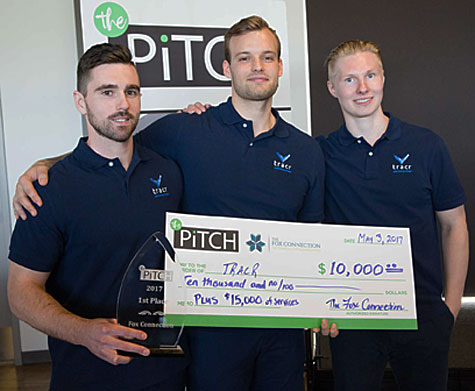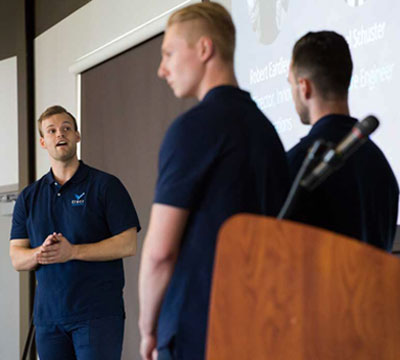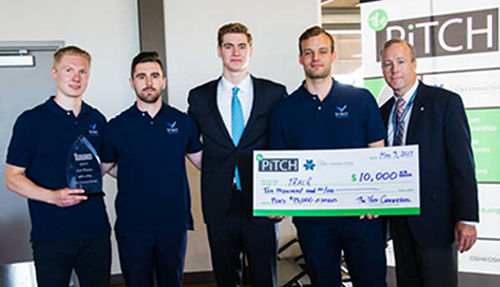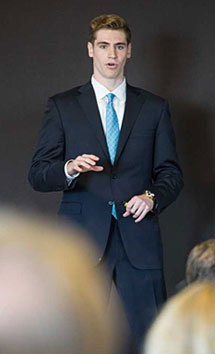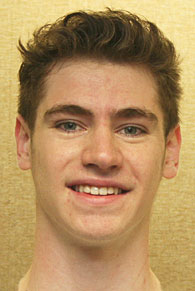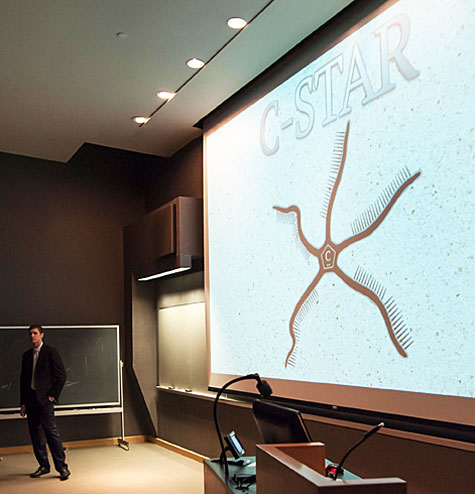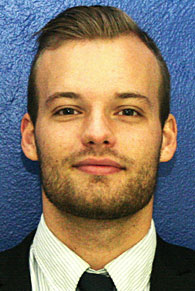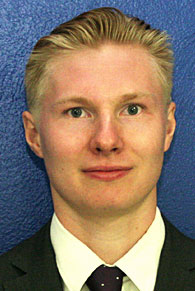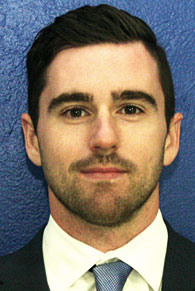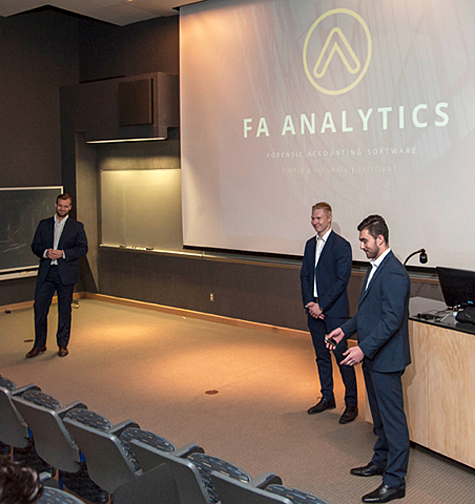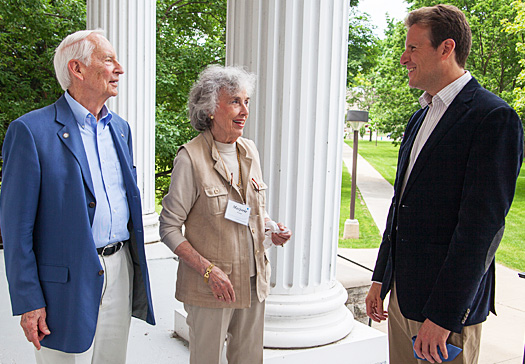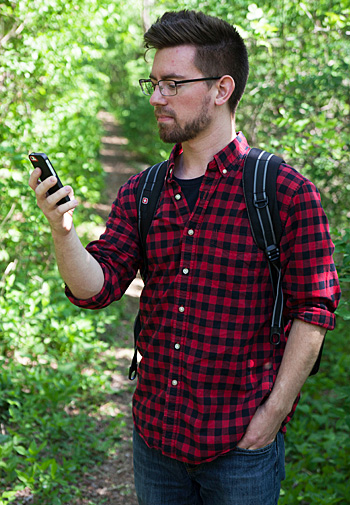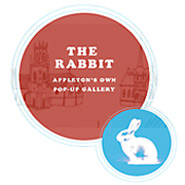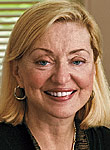Two for two!
For the second year in a row, a team of Lawrence University budding entrepreneurs wowed the judges to earn first-place honors in the second annual northeast Wisconsin The Pitch competition held April 11 at Fox Cities Stadium.
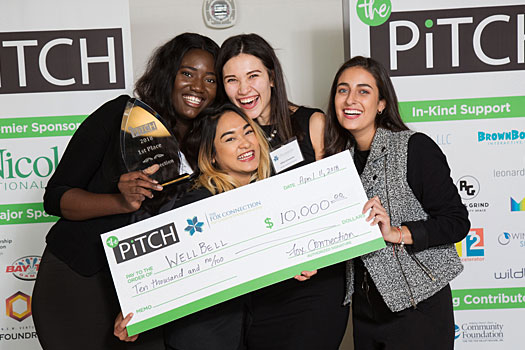
While a trio of Lawrence hockey players won the inaugural Pitch event in 2017, it was the ladies turn to shine in the spotlight this time.
A team of four international students — Ayomide Akinyosoye, Lagos, Nigeria, Alejandra Alarcon, Quito, Ecuador, Nikki Payne, Bangkok, Thailand, and Alfiza Urmanova, Arsk, Russia — overcame a technological hiccup to win the first-place prize of $10,000 in cash and $15,000 in in-kind professional startup assistance.
Despite a computer glitch that prevented their visuals from being shown during their presentation, the four junior economics majors didn’t miss a beat in confidently touting the importance and benefits of their idea, WellBell, an innovative wristband device with an S.O.S button that can be used to send notifications for help or medical assistance. The team sees potential markets for WellBell in health areas as well for social emergencies, such as sexual assaults or shootings.
“I just knew we were going to win,” said an ebullient Alarcon.
Payne was a bit less confident, but equally happy.
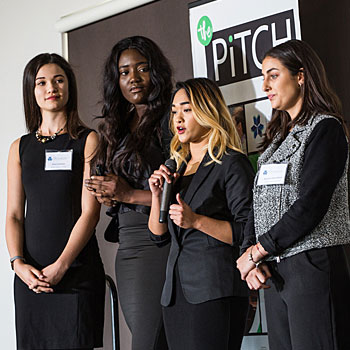
“What?!? Are you serious?” Payne said was her initial reaction. “I was really surprised. There were great teams out there and we saw some great products they came up with. I thought, ‘I don’t know, I don’t think we’re going to win’ and then when they called our name it was like, ‘okay…guys we did it.’”
Urmanova is credited with conceiving the idea for WellBell this past January. She says the next step is to create a prototype.
“This prize money will help us with beta testing,” explained Urmanova. “Once we test the product, we’ll be able to launch it. For now, we need to see if the market is ready for it. This is something that hasn’t been done before, but it’s very simple and not too complicated. We have a plan on how we want to manufacture it, so within two, three years, it’s possible it will be on the market.”
Modeled after the television show “Shark Tank,” The Pitch featured 10 teams of student entrepreneurs presenting their business idea to a panel of judges and a room full of business leaders and mentors. Each presenter is given five minutes to pitch their product or idea and then answer questions from the judges.
The competition featured two teams each from St. Norbert and Ripon colleges, UW-Green Bay and UW-Oshkosh as well as Lawrence, the only competing institution without a business program.
“I was really proud of the young ladies. Their power point didn’t work and yet they gave one heck of a presentation,” said Gary Vaughan, coordinator of the Innovation and Entrepreneurship Program at Lawrence University. “Women and entrepreneurship go together. There’s no reason why we can’t have more women pitching at events like this. For Lawrence to do this two years in a row against the quality of the other schools we have, it’s awesome.”
“It’s not just the (innovation and entrepreneurship) program, but the whole university and how we prepare our young people, how they present themselves, the confidence they show on stage.”
— Gary Vaughan
Vaughan says Lawrence’s success in the first two Pitch events transcends just the university’s innovation and entrepreneurship program.
“It’s not just the program, but the whole university and how we prepare our young people, how they present themselves, the confidence they show on stage,” said Vaughan.
“It’s the liberal arts foundation they have that we’re building from. The I & E program kind of complements all the other majors on campus. That’s one of our competitive advantages. We’re fining-tuning all the other majors in the way we’re teaching our students how to think entrepreneurially. That entrepreneurial mindset adds value to all of the majors at Lawrence.”
As for the prospects of WellBell, Vaughan thinks it has a future.
“It’s simple and it’s a contemporary solution to some of our challenges in society today,” said Vaughan. “With the prize money they have and the in-kind support, they’ll be able to do a prototype that will work. What we’re talking about with WellBell is your loved one’s security.”
Akinyosoye says Lawrence’s second straight winning Pitch speaks volumes about the importance of having innovative minds.
“It pushes you beyond the boundaries of the classroom and pushes your mind to explore things you didn’t think were possible,” said Akinyosoye. “Coming up with this (WellBell) was just a conversation in a room a few months ago and today it’s possible that it’s going to be a product in the future. The sky is just the beginning.”
“The future is female,” Alarcon added proudly, “and the future is now.”
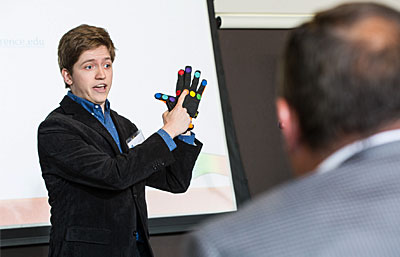
Brian Mironer, a junior from Edina, Minn., who won the on-campus LaunchLU pitch competition April 7, also represented Lawrence at The Pitch. During his presentation on “Guido,” his innovative way to teach music using a specialized glove and novel curriculum, Mironer had the judging panel singing “Do-Ra-Mi.”
Dayne Rusch from UW-Oshkosh was awarded $17,000 in cash and in-kind support as the second-place finisher for “Pyxsee,” an app that allows parents to monitor or limit their children’s time on social media. Sam Hunt of UW-Green Bay was award third place and $10,000 in cash and in-kind support for PrecisionLAG, a device attached to the grip end of a golf club to help the golfer make proper contact with the ball.
The Pitch competition features the best entrepreneurial ideas from college students in northeast Wisconsin, each of whom qualified through preliminary on-campus pitch competitions at their respective institutions.
The winners were chosen by a panel of five judges representing Nicolet Bank, Gulfsteam Aerospace, gener8tor, a startup accelerator, Baker Tilly Virchow Krause and Winnebago Seed Fund.
About Lawrence University
Founded in 1847, Lawrence University uniquely integrates a college of liberal arts and sciences with a nationally recognized conservatory of music, both devoted exclusively to undergraduate education. It was selected for inclusion in the book “Colleges That Change Lives: 40 Schools That Will Change the Way You Think About College.” Engaged learning, the development of multiple interests and community outreach are central to the Lawrence experience. Lawrence draws its 1,500 students from nearly every state and more than 50 countries.


